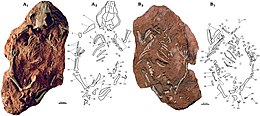| Catopsbaatar Temporal range: Late Cretaceous,
| |
|---|---|

| |
| The most complete skeleton (specimen PM120/107) shown from above (left, A) and below (right, B) as preserved, with diagrams showing individual bones | |
| Scientific classification | |
| Domain: | Eukaryota |
| Kingdom: | Animalia |
| Phylum: | Chordata |
| Class: | Mammalia |
| Order: | †Multituberculata |
| Family: | †Djadochtatheriidae |
| Genus: | †Catopsbaatar Kielan-Jaworowska, 1994 |
| Species: | †C. catopsaloides
|
| Binomial name | |
| †Catopsbaatar catopsaloides (Kielan-Jaworowska, 1974)
| |
| Synonyms | |
| |
Catopsbaatar is a genus of multituberculate, an extinct order of rodent-like mammals. It lived in what is now Mongolia during the late Campanian age of the Late Cretaceous epoch, about 72 million years ago. The first fossils were collected in the early 1970s, and the animal was named as a new species of the genus Djadochtatherium in 1974, D. catopsaloides. The specific name refers to the animal's similarity to the genus Catopsalis. The species was moved to the genus Catopsalis in 1979, and received its own genus (Catopsbaatar, Greek and Mongolian for 'visible hero') in 1994. Five skulls, one molar, and one skeleton with a skull are known; the last is the genus' most complete specimen. Catopsbaatar was a member of the family Djadochtatheriidae.
The skull of Catopsbaatar was up to 70 mm (2.8 in) long and, as in other multituberculates, proportionally large. The external appearance of these animals' heads may have been similar to those of rodents. The skull was heavy-set and wide, with the zygomatic arches strongly expanded to the sides. The eye sockets were smaller and placed further back than in its relatives, and the snout was more elongated. Catopsbaatar had semicircular ridges on the side of the skull, to which the jaw muscles were attached. The mandible was strong and very elongated. It had very robust incisors, and cheek teeth with multiple cusps (for which multituberculates are named). The pelvic bones differed from those of other multituberculates in that they were not fused to each other. Catopsbaatar had spurs on its ankles, like those of the male platypus and echidna, without evidence of a venom canal (present in the former).
The spurs of Catopsbaatar and other Mesozoic mammals may have been used for protection against theropod dinosaurs and other predators. Multituberculates are thought to have given live birth, and the fact that they had hair indicates they were homeothermic ("warmblooded"). Multituberculates would have been omnivorous; Catopsbaatar had powerful jaw muscles, and its incisors were well adapted for gnawing hard seeds, using a backwards chewing stroke. Multituberculates are thought to have had a sprawling posture, and Catopsbaatar may have been able to jump. Catopsbaatar is known from the Barun Goyot Formation, which is thought to be about 72 million years old.